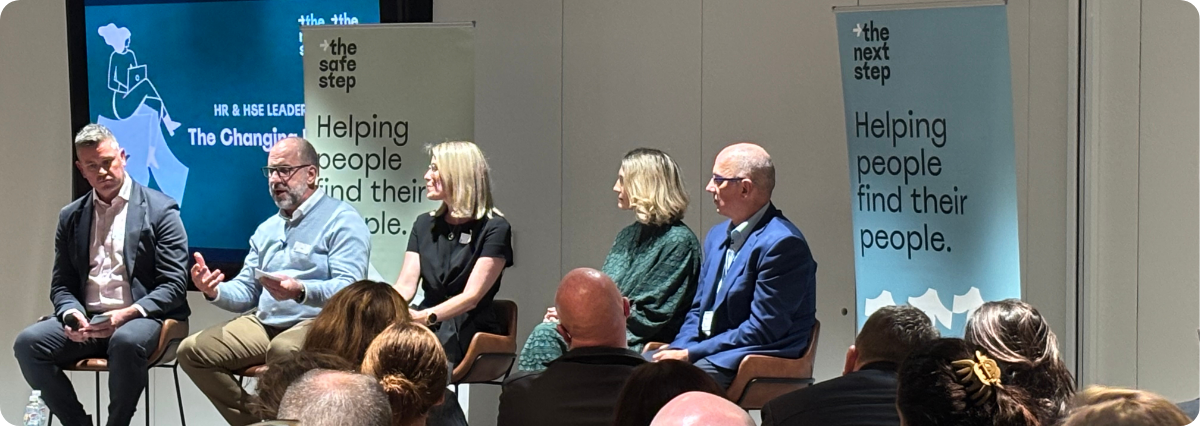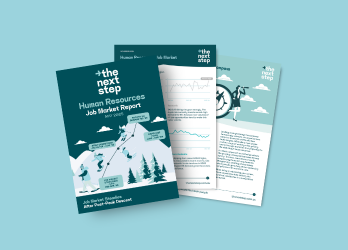The Skills Blind Spot Every CHRO Needs to See
As CHROs navigate business transformation, workforce planning and leadership succession challenges, a capability gap is emerging right under their noses. While portfolios expand to encompass AI implementation and psychosocial safety, many leaders underestimate how much closer their integration with safety functions needs to become—and the competitive advantage this represents.

Insights from The Next Step's recent HR & HSE Leadership Forum reveal how this convergence is reshaping capability requirements. Expert panellists at the forum explored the opportunities that emerge when HR leaders recognise this blind spot and the risks of remaining unaware of these subtle but significant shifts in the professional landscape.
The convergence rewriting the rules
While CHROs focus on strategic priorities like culture change and succession planning, regulatory boundaries are dissolving beneath them. "With the introduction of the psychosocial regulations and the Respect@Work amendments, we are seeing a real convergence of HR and WHS laws, with traditional HR domains now squarely part of WHS compliance" explains Caitlin Ible, Partner at MinterEllison.
The consequences of missing this shift are significant. Recent coronial inquests reveal that "cross-functional breakdown between safety and people teams is being identified as the root cause of psychological injuries and missed opportunities for intervention," Ible notes. The numbers tell the story: mental health claims by workers aged 30-40 have surged 730% over ten years, while NSW workers compensation costs jumped from $4.4 billion to $5.3 billion in just one year.
When HR and safety teams operate in silos, these escalating costs compound—and important warning signals disappear into organisational blind spots.
The data revolution HR leaders are missing
For HR leaders accustomed to protecting employee information, the new environment demands rethinking traditional boundaries. As Rob Tanti, Chief People Officer at Opal, explains: "You put safety and HR together and you actually perfect the formula. You've got all the information needed to position your organisation upstream rather than reactive."
The practical reality is clear. Rod Maule, Safety Executive and Strategic Advisor, describes the daily challenge: "We've all got reporting systems for safety, then HR receives a bullying complaint. Where does it go and who sees it?" This data fragmentation creates dangerous blind spots where patterns remain invisible until they become crises.
Progressive organisations are implementing structured protocols where safety incidents automatically trigger HR reviews, and HR concerns prompt safety assessments. Aaron Neilson, CEO of The Next Step, observes the market evolution: "In the past year we've recruited for newly created roles that blur the lines between HR and HSE, including a 'Head of People Care' which drives unified enterprise ER and WHS strategic agenda."
Elevating HR through integration mastery
This convergence creates an elevation opportunity for HR leaders ready to expand their strategic influence. You're no longer confined to traditional HR boundaries; you're becoming integral to organisational resilience.
Consider this scenario: you know which managers have high turnover, but you might not know they also have elevated safety incidents. When you connect these dots, you're not just solving retention—you're preventing potential workplace tragedies and protecting your organisation from significant legal and reputational risks.
As workplace mental health consultant Anna Feringa notes: " Poor interpersonal relationships, conflicts, and poorly executed performance management practices account for a large portion of Workers compensation claims, closely followed by workload. You're actually in control of more of those risks than traumatic events."
Your expertise in recruitment, performance management, and culture development directly impacts your organisation's safety profile. Every HR initiative becomes a safety intervention; every safety challenge becomes an HR opportunity.
The technology integration imperative
Looking ahead, AI and digital transformation demand even greater collaboration. Ible highlights emerging challenges: "There's discussion of AI being identified as a high-risk health and safety hazard. With wearable technologies and privacy concerns around employee surveillance, how we integrate technology safely requires both safety and people expertise."
Maule's experience at Australia Post demonstrates the potential: "We achieved a 98% reduction in people-plant exposure incidents through safety technology. But success required working with HR, operations, and IT to educate people, redesign workflows, and implement barriers—not just deploy technology."
The opportunity lies in making integrated information accessible to line managers in real-time. Imagine supervisors accessing guidance that considers both HR policies and safety requirements for any situation they face. This reduces bureaucracy while dramatically improving decision-making quality.
The capabilities defining tomorrow's HR leaders
The integration demands new capabilities from HR professionals.
- Cross-functional literacy: Understanding safety frameworks well enough to collaborate meaningfully, and translating HR processes into safety-relevant insights that reveal organisational health patterns.
- Data integration mastery: Moving beyond separate reporting systems to create unified insights about employee risk and wellbeing that illuminate previously invisible organisational vulnerabilities.
- Complex change leadership: Managing technology implementation and cultural shifts affecting both safety and people outcomes while navigating competing priorities and stakeholder interests.
- Regulatory navigation expertise: Understanding how compliance requirements intersect and creating coherent organisational responses rather than competing functional messages that confuse strategic decision-making.
Your competitive advantage in the new landscape
For HR leaders willing to develop these capabilities, the benefits extend far beyond compliance. Feringa notes shifting employee expectations: "Good candidates don't just follow pay packets anymore. People are putting their health before wealth—that's a change I'm seeing across the board."
Organisations successfully integrating HR and safety functions capture multiple advantages: talent attraction to psychologically safe workplaces where wellbeing isn't rhetoric, risk mitigation through early warning systems that prevent costly incidents, cultural strength that drives both performance and wellbeing sustainably, and board confidence through comprehensive people risk management.
Practical steps for HR leaders
These insights from The Next Step's HR & HSE Leadership Forum translate into actionable steps you can implement immediately:
- Think employee experience first: Design initiatives around what employees need rather than functional structures, allowing natural integration to emerge.
- Start with shared outcomes: Instead of managing separate safety and HR metrics, focus on integrated measures of employee experience and organisational performance.
- Develop bridge skills: Invest in capabilities that span traditional boundaries. Understanding basic risk assessment principles enhances people strategy; systems thinking improves both safety and engagement outcomes.
- Build joint capability development: Create training programmes that build understanding across domains rather than reinforcing silos, developing leaders who can navigate both people and safety challenges with equal fluency.
- Establish integrated governance: Provide coherent insights rather than competing functional perspectives, enabling strategic decision-making based on comprehensive organisational intelligence.
- Design collaborative technology implementation: Ensure both people and safety considerations are built into digital transformation from conception, preventing costly retrofitting and resistance.
- Leverage specialist expertise: Work with recruitment partners like The Next Step who understand both domains to identify integration opportunities and find professionals with hybrid capabilities.
The key to successful implementation, according to Tanti, is proving value early: "Pick a site everyone knows is struggling. Implement integrated approaches and track both traditional metrics and cross-functional indicators. This creates compelling proof points for broader rollout."
The leadership opportunity ahead
The most successful HR leaders aren't trying to become safety experts overnight. Instead, they're developing competency in systems thinking, understanding interconnections, and creating accountability structures that support integrated outcomes.
"HR leaders who can navigate these integrated approaches will build more resilient, adaptive organisations. The capability to think holistically about employee experience—considering all factors that influence performance and wellbeing—becomes a competitive advantage," says Neilson.
The expansion of HR responsibilities to encompass broader employee risk and wellbeing isn't slowing down. For HR leaders willing to develop these integrated capabilities, it represents an opportunity to drive unprecedented value for their organisations and create truly compelling employee experiences.
The question isn't whether this integration will continue, but how quickly HR leaders can develop the skills needed to lead it effectively.
The blind spot becomes clear when you know where to look—and the competitive advantage belongs to those who see it first.



